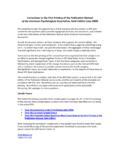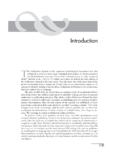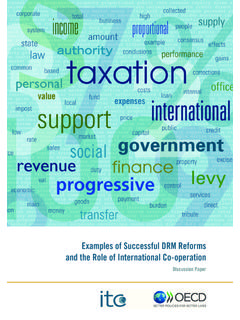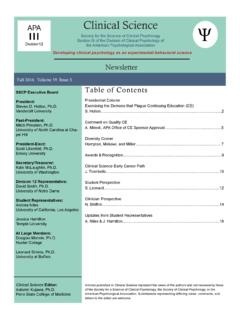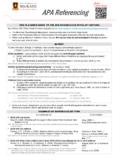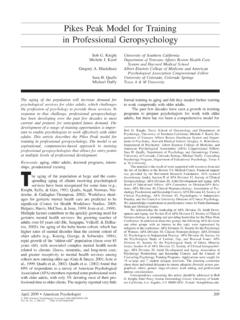Transcription of Code of FairTesting Practices inEducation
1 CodeofFair testing Practicesin EducationCodeofFair testing Practicesin EducationCONTENTS4 Developing and SelectingAppropriate Tests6 Administering andScoring Tests8 Reporting and Interpreting Test Results10 Informing Test Takers11 Working Group2he code of fair testing Practices in Education ( code )is aguide for professionals in fulfilling their obligation to provide and use tests that are fair to alltest takers regardless of age, gender, disability, race, ethnicity, national origin, religion, sexual orientation,linguistic background, or other personal is a primary consideration in all aspects of testing .
2 Careful standardization of tests and administration conditions helps to ensure that all test takers are given a comparable opportunity todemonstrate what they know and how they can performin the area being tested. Fairness implies that every testtaker has the opportunity to prepare for the test and isinformed about the general nature and content of thetest, as appropriate to the purpose of the test. Fairnessalso extends to the accurate reporting of individual andgroup test results. Fairness is not an isolated concept, but must be considered in all aspects of the testing Codeapplies broadly to testing in education (admissions, educational assessment, educational diagnosis, and student placement) regardless of themode of presentation, so it is relevant to conventionalpaper-and-pencil tests, computer-based tests, and performance tests.
3 It is not designed to cover employment testing , licensure or certification testing , or other types of testing outside the field of Codeis directed primarily at professionally developed tests used in formally administered testingprograms. Although the Codeis not intended to covertests prepared by teachers for use in their own classrooms, teachers are encouraged to use the guidelines to help improve their testing Codeaddresses the roles of test developers and testusers separately. Test developersare people and organizations that construct tests, as well as those that set policies for testing programs.
4 Test usersarepeople and agencies that select tests, administer tests,commission test development services, or make decisions on the basis of test scores. Test developer and test user roles may overlap, for example, when aThe Codehas been prepared by the Joint Committee on TestingPractices, a cooperative effort among several professional organizations. The aim of the Joint Committee is to act in the public interest to advance the quality of testing Practices . Membersof the Joint Committee include the American Counseling Association(ACA), the American Educational Research Association (AERA), theAmerican Psychological Association (APA), the American Speech-Language-Hearing Association (ASHA), the National Association ofSchool Psychologists (NASP), the National Association of TestDirectors (NATD), and the National Council on Measurement inEducation (NCME).
5 T3state or local education agency commissions test development services, sets policies that control the testdevelopment process, and makes decisions on the basisof the test of the statements in the Coderefer to the selection and use of existing tests. When a new test is developed, when an existing test is modified, or when the administration of a test is modified, the Codeis intended to provide guidance for this process.*The Codeprovides guidance separately for test developers and test users in four critical areas:A. Developing and Selecting Appropriate TestsB.
6 Administering and Scoring TestsC. Reporting and Interpreting Test ResultsD. Informing Test TakersThe Codeis intended to be consistent with the relevantparts of the Standards for Educational andPsychological testing (American Educational ResearchAssociation [AERA], American Psychological Association[APA], and National Council on Measurement inEducation [NCME], 1999). The Codeis not meant to addnew principles over and above those in the Standards orto change their meaning. Rather, the Codeis intended torepresent the spirit of selected portions of theStandards in a way that is relevant and meaningful todevelopers and users of tests, as well as to test takers and/or their parents or , districts, schools, organizations, and individual professionals are encouraged to commit themselves to fairness in testing and safeguarding the rights of testtakers.
7 The Codeis intended to assist in carrying outsuch commitments.* The Codeis not intended to be mandatory, exhaustive, or definitive, and may not be applicable to every situation. Instead,the Codeis intended to be aspirational, and is not intended to take precedence over the judgment of those who have competence in the subjects 2004 by the Joint Committee on testing Practices . Thismaterial may be reproduced in its entiretywithout fees or permis-sion, provided that acknowledgment is made to the Joint Committeeon testing Practices . Any exceptions to this, including requests toexcerpt or paraphrase this document must be presented in writ-ing to Director, testing and Assessment, Science Directorate,APA.
8 This edition replaces the first edition of the code , which waspublished in 1988. Please cite this document as follows: code of FairTesting Practices in Education.(2004). Washington, DC: Joint Committeeon testing Practices . (Mailing Address: Joint Committee on TestingPractices, Science Directorate, American Psychological Association,750 First Street, NE, Washington, DC 20002-4242; evidence of what the test measures, the recommended uses, the intended test takers, andthe strengths and limitations of the test, includingthe level of precision of the test how the content and skills to be testedwere selected and how the tests were information about a test s characteristics at a level of detail appropriate to the intended test guidance on the levels of skills, knowledge, and training necessary for appropriatereview, selection, and administration of evidence that the technical quality.)
9 Including reliability and validity, of the test meets itsintended to qualified test users representative samples of test questions or practice tests, directions, answer sheets, manuals, and score potentially offensive content or languagewhen developing test questions and related appropriately modified forms of tests or administration procedures available for test takers with disabilities who need special and provide evidence on the performance oftest takers of diverse subgroups, making significantefforts to obtain sample sizes that are adequate forsubgroup analyses.
10 Evaluate the evidence to ensurethat differences in performance are related to theskills being DevelopersTest developers should provide the information andsupporting evidence that test users need to selectappropriate and SelectingAppropriate the purpose for testing , the content and skillsto be tested, and the intended test takers. Selectand use the most appropriate test based on a thorough review of available and select tests based on the appropriateness of test content, skills tested, and content coverage for the intended purpose of materials provided by test developers andselect tests for which clear, accurate, and completeinformation is tests through a process that includes persons with appropriate knowledge, skills.










